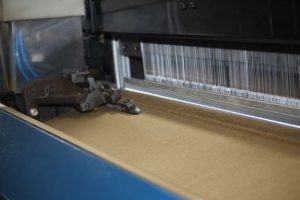
Deep rooted family values and a growth mindset keep technical weaving company Schneider Mills well-positioned for the future.
By Rachael S. Davis, Executive Editor
Meet George Shtohryn and Tim Little, the dynamic duo at the helm of fourth-generation, family-owned company Schneider Mills Inc., Taylorsville, N.C. The co-presidents split management duties with Shtohryn handling sales and fabric development from a New York City-based office, and Little overseeing production at the company’s 450,000-square-foot, state-of-the-art weaving mill in Taylorsville. Shtohryn is the more outgoing and gregarious of the two, as one might expect from someone in sales; and Little slightly more reserved. But both are equally passionate about what they do and the company they work for.
Between them they have 64 years with the company — Little in his 39th year and Shtohryn his 25th year. The company also has 15 employees on staff with more than 40 years of service and one lab employee celebrating her 50th year with the Schneider Mills this year. Amazingly, Mary Wike, a long-time lab employee who sadly passed away last year, had spent 62 years as a Schneider employee.
The company states it was “built upon Samuel Schneider’s ethic for family, work and community,” and clearly, this technical weaving company is a special place to work as illustrated by the long tenure of so many employees.
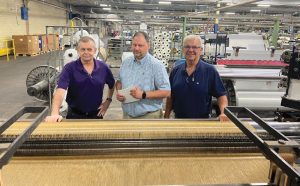
Room superintendent, Curt Parker,
vice president of operations, and Chip Swinnie, vice president of manufacturing, who have 31, 30 and 20 years of service respectively with Schneider Mills.
Small Beginnings
Founded in 1917 by Samuel Schneider, the company began life as a small silk weaving business in Haledon, N.J. The company expanded in the Northeast and developed a reputation within the New York converting trade.
In 1938, Schneider’s oldest son, Isadore Schneider, took over running the business. Isadore managed sales, while his brother Albert was over manufacturing.
In 1946, the company established a manufacturing operation in Taylorsville, N.C., where it ultimately consolidated its manufacturing operations.
“Schneider was following a trend that I think a lot of companies in the textile industry and other businesses were caught up in during the 1940s, which was to move further and further south,” Shtohryn said. “The trend was based on the labor situation and lack of unionization.”
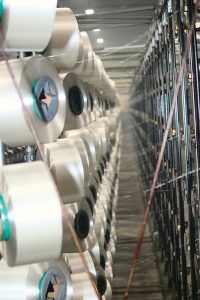
“The company picked Alexander County, N.C., because it’s the largest county in North Carolina by land, but had least amount manufacturing in the state,” Little added. “The Schneider’s figured there were farm hands with families in the county and perhaps they could introduce some of those people to manufacturing.”
Albert and Isadore both passed away in recent decades leaving the company in the hands of the next generation.
Capabilities, Products
Over the company’s 100-year-plus history, its product line and manufacturing capabilities have evolved. The company’s focus today is on technical woven fabrics, and it sells exclusively greige fabric made using nylon, polyester or acetate ranging from 30 to as high as 1,260 denier. Fabrics may have plain or fancy dobby patterns and range in weight from 0.5 to 12 ounces per square yard.
The undyed fabrics, though some may be solution-dyed, require downstream processing by Schneider’s customers to meet the requirements for the targeted end-use. In some cases, the same base fabric can end up in entirely different applications depending on the type and number of downstream processes it is subjected to.
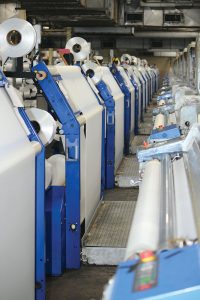
“We take the raw yarns and weave them to a specification required by our customers, who then treat the fabric in additional processing steps to make it end-use specific,” Shtohryn said. “There are so many things that happen to our fabric in downstream processing. It almost always starts with scouring. From there, fabrics may be dyed, printed and heat-set. Some customers might apply durable water-repellent or flame-retardant finishes. Others may coat and/or laminate the fabric. We have one particular customer who subjects our fabric to more than 20 different steps in downstream processing to meet their specifications.”
A large portion of Schneider’s fabrics end up in military applications. Additionally, these same fabrics might be used by law enforcement, the FBI, and U.S. Forest Service, among other government agencies. End products include backpacks, human and cargo parachutes, as well as protective equipment such as vests. “We hold the Berry Amendment very, very dear,” Shtohryn said. “It is very important to our business, and also assures that our military is supplied with consistent products that live up to specifications.” The Berry Amendment requires that the U.S. Department of Defense procure goods — which includes clothing, fabrics, fibers, yarns and other made-up textiles — produced in the United States and not from foreign sources.
Applications for the products aren’t limited to just military and protective equipment end-uses however. Schneider’s acetate taffeta winds up in surgical tape. Another substrate is silicon coated and used in airbags. The company also has a large business in fabrics for country and organizational flags and banners.
“Some of our customers own their own processing facilities, and there are other independent processing facilities that many of our customers use,” Shtohryn noted. “There is an agility to our distribution, and there is a specialty in some of these processing facilities that perhaps the larger companies do not have.”
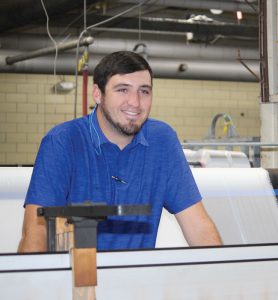
Flexibility, Accepting Of Change
Little notes that the company is highly flexible from the machinery it operates, to the mindset of the employees running the constantly changing products. “I can remember one of Albert’s old sayings — the loom doesn’t care what kind of fiber it’s running, it just has to be flexible enough to run the different fibers,” Little stated. “That’s one of the key things they did here is to build the manufacturing plant based on flexibility.” According to Little, in the years he’s worked at Schneider Mills, the company has moved from Draper looms to rapier machines to water-jet and air-jet weaving machines. Weaving speeds currently range between 800 and 1,100 picks per minute. “We pride ourselves on the speeds we run and the quality that comes off the looms,” Little said.
“Most people are reluctant to change,” Little said. “But out in the mill, our employees know that what’s running on the loom today, may not be there tomorrow. We may have a loom running a 30-denier parachute fabric today, and tomorrow, we need to run a 1,000-denier Cordura® on the same machine. Our employees know to expect change, they accept it, and that makes us strong.”
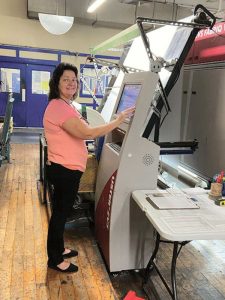
Little and Shtohryn also credit much of the company’s success to its philosophy of never saying “no.” Schneider is quite often approached by a customer that knows the company’s capabilities and has a particular fabric construction in mind. “’Do you think we can develop this product together?’ is a question we are often asked,” Shtohryn mentioned. “Knowing the diverse capabilities and expertise at the plant, along with the willingness of our plant associates, the answer is almost always yes.
“It’s a company-wide philosophy that goes back to Albert and Isadore who said send us a sample, and we’ll make it,” Shtohryn continued. “No one says no, at least not without trying!”
“I’m not saying we can make everything,” Little added. “But we will give it a try and the flexibility in the plant allows us to do just that. The only limitations are the minimum and maximum widths.”
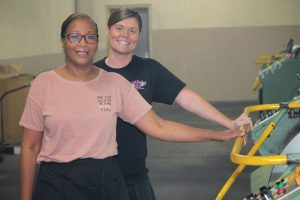
Agility
Agile also is a word Shtohryn used to describe the company. “It’s manufacturing agility, it’s marketing agility, and it’s also from a strong financial backbone the company possesses,” Shtohryn noted. “Today, we consider ourselves to be professionally run, yet family owned. And we have the full support of the family to do what’s necessary to keep the business thriving the way it has for more than 100 years.”
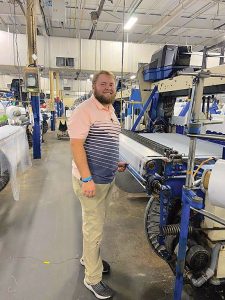
Labor, Supply Chain Challenges
Recently, the company has experienced some labor challenges and supply chain issues. “There have been labor challenges nationwide and we’re not immune to that,” Shtohryn said. “But we were quite fortunate and did not have to furlough during the initial stages of the pandemic. However, as for many companies today, labor availability remains challenging for Schneider.”
“Speaking of the workforce, we are very fortunate in some ways,” Little added. “We’ve actually gained some employees now that the unemployment situation has changed. And we have second-, third- and even some fourth-generation family employees working at Schneider. That family aspect has really helped us keep employees on staff.”
But Schneider Mills wants to shake the general perception that the textile industry is not a glamorous sector to work in. The U.S. textile industry has changed immeasurably since the days of sweatshops; the movie “Norma Rae;” and dingy, dusty cotton plants. The industry is modern and high tech — both in the products it makes and the facilities that make them — and Schneider is a perfect example of a modern, technical weaving plant.
“Even though we are a technical weaver, we still suffer the stigma of textiles from long ago,” Little said. “We have highly technical, computerized machines and we are trying to strongly promote that idea in our community and make known the employment opportunities available at Schneider Mills. We still have a difficult time getting across the idea that it is not the textile industry of years ago.”
Supply chain issues — from occasional spare parts or raw materials shortages and surcharges, as well as increased shipping costs — have not impacted Schneider Mills’ philosophy of doing business. “Since we are generally speaking in partnership with our supply chain, we’re not the only ones having to pass on various increases,” Shtohryn said. “There truly is a partnership approach in our distribution, and we’re in this to survive together and thrive together.”
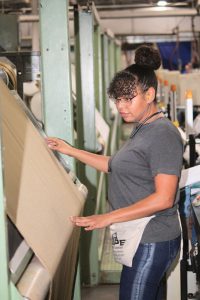
Business Diversification
Approximately 12 years ago, Albert Schneider began researching carbon fiber weaving as a way to use the company’s expertise and branch out.
The end result is a wholly owned subsidiary of Schneider Mills named Composite Fabrics of America (CFA). The business is run by Albert’s grandson, Matthew McPherson. CFA weaves carbon and para-aramid fibers for composite applications in aerospace, automotive, recreation and infrastructure repair markets.
“The business is still young, but we’re doing some pretty neat things,” Little said. “These markets are really highly specified and hard to get into, but the business is growing and it’s a different avenue for us to use our expertise in weaving.”
“CFA is an off-shoot and a different market, but I do think it complements our business,” Shtohryn said. “We have customers because of their exposure to military technology, mostly through soft goods, that touch on the fringes of fabrics for hard goods. This has created some opportunities for CFA that we hope will bear fruit.”
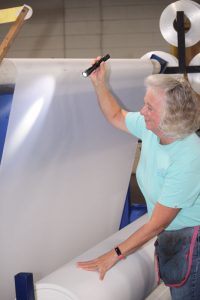
Kathy Childers
inspecting fabric
Well Positioned For The Future
“You never know what’s going to happen tomorrow as far as the challenges that may come our way,” Little mused. “The fact we don’t say no to anything makes every day challenging. What we are doing, is trying to do it better every day. Trying to find a way to make sure the quality is better and trying to reduce the price by even just half a penny per yard to stay competitive. There is always something we can do better.”
“Our customer base is highly entrepreneurial, extremely creative and many of the individuals have been around for a while,” Shtohryn said. “Over time we have built a strong level of communication and trust. It’s a great supply chain to be a part of. Innovation is one of the best defenses, along with the Berry Amendment, that we have as a company and as a supply chain. It’s also that cooperative effort that goes into maintaining or gaining efficiencies to keep a robust supply chain. As soon as someone thinks they are going to knock us off, we’re on to the next thing.”
Agility, flexibility, a growth mindset and strong family values define Schneider Mills. The lessons learned from previous generations — including the philosophy of never saying “no” — puts the company in a great position for the future. The family business and Albert and Isadore’s legacy remains in good hands.
September/October 2021




